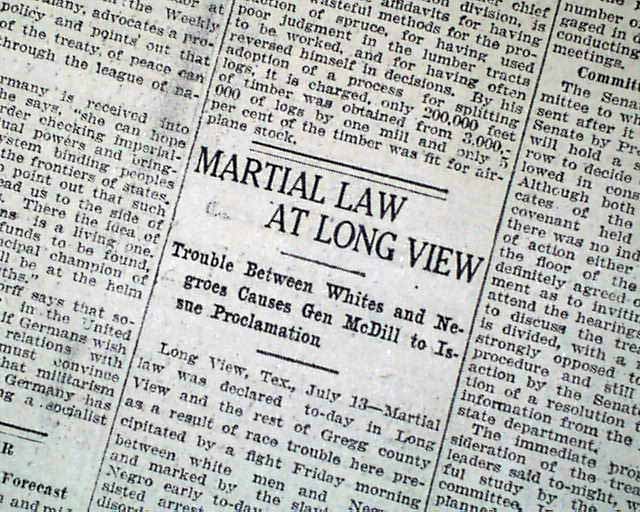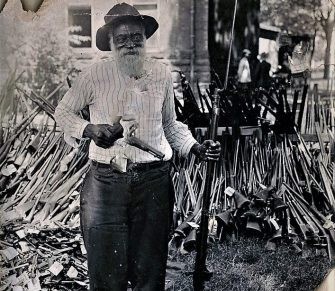National Guard Post During the Longview Race Riot
Introduction
Text-to-speech Audio
Images
Newspaper clipping published on July 14, 1919

Photo of Longview citizen Daniel Hoskins with citizen's guns collected at the courthouse during martial law - July 13, 1919

Backstory and Context
Text-to-speech Audio
For multiple days in a row, armed white mobs roamed the streets of Longview. Compared to other events collectively known as race riots in 1919, there was relatively little physical violence against property and persons following the initial destruction of the homes of several members of the Black community. Many African Americans urged government officials to intervene and come to their aid, and some Black veterans were well-trained and armed, including a group that kept a white mob from burning down one home at least until that mob returned later in the evening with reinforcements.
While both white and Black citizens were injured or negatively affected by the riots, it was the Black community whose neighborhood and leaders were facing ruin. The death of Marion Bush, a local farmer, led local officials to contact Texas Governor William P. Hobby for assistance. Governor Hobby sent multiple soldiers and Texas Rangers to Longview and declared martial law in Gregg County on July 13, 1919. General Robert H. McDill split the city into two and installed a city-wide curfew. McDill also ordered every citizen of Longview and Kilgore to surrender their weapons at the courthouse or risk their homes being searched and fined for any weapons not turned in. As many know, Texans love their guns, and the courthouse received 5-7,000 guns upon McDill's order.
McDill created a committee of local citizens that sought to restore "peace" to Longview. The committee came out and shared their disapproval on Jones' article, as well as the Black armed defense that took place at his home upon the white mob's arrival. The committee objected to the burning and destruction that occurred on Harrison Street and in the Black community. The Texas Rangers arrested the men involved in the attack on Jones, his home, and those who participated in arson. The arrests consisted of both white and Black men. The Black men were sent out of town to await their hearings due to the fear that more lynchings and rioting would occur otherwise.
As the citizens' anger began to fade, Governor Hobby ended martial law on July 18, 1919. Citizens came back into possession of their weapons, and many attempted to restore a sense of harmony between all races. In the end, none of the Black or white rioters were tried for their offenses. On the one hand, this can be viewed as a positive move on the city's part. The chances of the white rioters being acquitted and the Black rioters imprisoned would have been high and possibly lead to even worse riots. On the other hand, justice was lost when it came to the lives of Lemuel Walters and Marion Bush, as well as the property and livelihood of those close with Dr. Davis and Jones. Dr. Davis and Jones left Texas, and many of the Black citizens acquitted were told not to return to Longview in order to keep law and order.
Sources
Durham, Ken. (2020) Longview Race Riot of 1919.” TSHA, 2020.
Evans, Glenn, and Les Hassell. (2020). News-Journal Photo. “Longview's Deadly 1919 Race Riot: Passed down Memories, No Markers.” Longview News Journal.
Glasrud, B.A. (2015). Anti-Black Violence in Twentieth-Century Texas. College Station: Texas A&M University Press.
“Martial Law At Long View” (1919, July 14). Springfield Republican, Springfield, Massachusetts. Retrieved from https://www.rarenewspapers.com/view/583310.
Library of Congress
